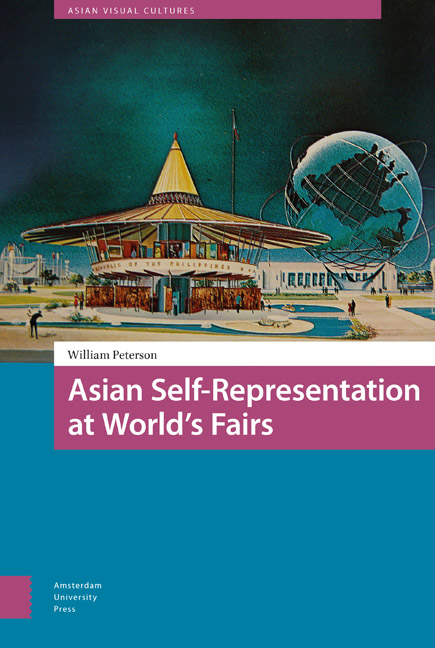Book contents
- Frontmatter
- Dedication
- Contents
- List of Figures
- Acknowledgements
- Note on Works Cited
- Note on Asian Names
- 1 Introduction: Setting the Stage
- 2 The Master of the Form: Japan at San Francisco's 1915 Panama-Pacific International Exposition
- 3 The New China and Chinese-Americanness: China at San Francisco's 1915 Panama-Pacific International Exposition
- 4 Performing Japan in the ‘World of Tomorrow’: Japan at the 1939-1940 New York World's Fair
- 5 From ‘Panda Diplomacy’ to Acrobat Diplomacy: China at the Brisbane's Expo ‘88
- 6 Fashion, Dance, and Representing the Filipina: The Philippines at the 1964-1965 New York World's Fair
- 7 Performing Modernity under Sukarno's ‘Roving Eye’: Indonesia at the 1964-1965 New York World's Fair
- 8 Maximizing Affect, Minimizing Impact with Hansik: South Korea at the 2015 Milan International Exposition
- 9 Hard and Soft Power in the Thai Pavilion: The Spectral Presence of King Bhumibol at the 2015 Milan Exposition
- 10 Conclusion: The Future of Asian Self-Representation at the International Exposition
- Works Cited
- Index
8 - Maximizing Affect, Minimizing Impact with Hansik: South Korea at the 2015 Milan International Exposition
Published online by Cambridge University Press: 21 November 2020
- Frontmatter
- Dedication
- Contents
- List of Figures
- Acknowledgements
- Note on Works Cited
- Note on Asian Names
- 1 Introduction: Setting the Stage
- 2 The Master of the Form: Japan at San Francisco's 1915 Panama-Pacific International Exposition
- 3 The New China and Chinese-Americanness: China at San Francisco's 1915 Panama-Pacific International Exposition
- 4 Performing Japan in the ‘World of Tomorrow’: Japan at the 1939-1940 New York World's Fair
- 5 From ‘Panda Diplomacy’ to Acrobat Diplomacy: China at the Brisbane's Expo ‘88
- 6 Fashion, Dance, and Representing the Filipina: The Philippines at the 1964-1965 New York World's Fair
- 7 Performing Modernity under Sukarno's ‘Roving Eye’: Indonesia at the 1964-1965 New York World's Fair
- 8 Maximizing Affect, Minimizing Impact with Hansik: South Korea at the 2015 Milan International Exposition
- 9 Hard and Soft Power in the Thai Pavilion: The Spectral Presence of King Bhumibol at the 2015 Milan Exposition
- 10 Conclusion: The Future of Asian Self-Representation at the International Exposition
- Works Cited
- Index
Summary
Abstract
With its theme of ‘Feeding the Planet: Energy for Life,’ the 2015 Milan Exposition offered a unique opportunity for smaller Asian nations to present their unique culinary heritage before a largely Italian audience. Korea took the fair's theme seriously, seeking to educate audiences about the health benefits of hansik, its distinctive, often fermented, vegetable-heavy cuisine. The Korean pavilion brought fairgoers inside the experience of how the cuisine works, virtually on a cellular level, in a highly aestheticized environment resembling an art installation. While hansik probably won few Italian converts, the youthful energy and exuberance reflected in the pavilion and its guides that exploded onto the streets of Milan during Korea week in June 2015 reflected its positive international cultural branding.
Keywords: Korea, hansik, foodways, affect, art installation
With its theme of ‘Feeding the Planet: Energy for Life,’ the 2105 Milan International Exposition sought to link food cultivation, production, and consumption practices with the demands they place on our planet. Fair organizers wished to create ‘an Expo in which content and container, signifier and signified, are therefore no longer separated but become a single whole’ (Milan Expo 2015a, p. 5). Possibly no country took this brief as seriously as South Korea (Republic of Korea), with their ambitious theme, ‘Hansik, Food for the Future: You Are What You Eat.’ Hansik, Korea's vegetable-heavy cuisine which features fermentation, was set out as a solution to the problems of world hunger, obesity, and scarce resources. This chapter considers how the pavilion's interactive installations and its attractive, young Korean hosts maximized the possibilities for generating affect, generating an energy that exploded out into the city of Milan during ‘Korea Week’ in June. I will argue that the modes used to communicate the wonders of hansik largely failed to adequately consider the embodied and cultural dimensions of food, particularly for its largely Italian exposition audience. While the pavilion maximized affect by appealing to the visual and the aural faculties, offering spectators an extraordinarily well integrated, intelligent, and beautifully aestheticized experience, it did not engage the senses of taste and smell, essential pleasure centres for the experience of food.
- Type
- Chapter
- Information
- Asian Self-Representation at World's Fairs , pp. 227 - 254Publisher: Amsterdam University PressPrint publication year: 2020



